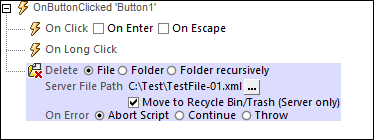Delete File/Folder
Deletes the selected file/folder on the client/server when the action is executed. Only one file/folder can be deleted per action. If you wish to delete multiple files/folders, use the action repeatedly.

•What to delete: Select whether you wish to delete: (i) a file, (ii) a folder (which is empty; if not empty, the folder will not be deleted ), or (iii) a folder recursively (the entire contents, including sub-folders, will be deleted).
•File/Folder path: The path to the file or folder to be deleted.
•Move to Recycle Bin: If this option is selected and a recycle bin exists on the server, then the file/folder is moved there. If the option is selected and no recycle bin exists on the server, then the file/folder is not deleted.
Error processing
The On Error option lets you define what should be done if an error occurs. Since the error handling can be precisely defined for this action, errors on such actions (that provide error handling) are treated as warnings—and not errors. The advantage is that you do not need to check errors on actions for which error handling has already been defined. The following error handling options are available:
•Abort Script: After an error occurs, all subsequent actions of the triggered event are terminated. This is the default action if an error occurs. If you wish to continue despite an error, select either the Continue or Throw option.
•Continue: Actions are not terminated. Instead, you can select what to do in either event: when there is no error (On Success), or when there is an error (On Error). For example, you might want to display a message box saying whether a page load was successful or not.
•Throw: If an error is detected, this option throws an exception that is stored in the Try/Catch action's variable. The Catch part of the Try/Catch action is used to specify what action to take if an error occurs. If no error occurs, then the next action is processed. See the section Try/Catch action for details.
For additional information about file locations on clients and server, see Tree Data and Load/Save Image.
MobileTogether extension functions
MobileTogether provides a range of XPath extension functions that have been specifically created for use in MobileTogether designs. Some functions can be particularly useful with specific actions. For example, mt-available-languages() returns the languages in which the solution is available and could, for example, be used with the Message Box action. If a function is especially relevant to this action, it is listed below. For a full list of extension functions and their descriptions, see the topic MobileTogether Extension Functions.